
The Quetzal is a large, brightly colored bird found in the cloud forests of Central America, particularly in Costa Rica and Guatemala.
Seeing a Quetzal for the first time can literally take your breath away. It is perhaps one of the most beautiful birds in the world and the settings in Costa Rica that you find them, such as a cloud forest, just adds to the beauty of this magnificent looking bird.
If you have never seen one, do yourself a favor and make it a point to do so. In this post, you’ll find 17 facts about the Quetzal, including size, strength, range and more.
Quetzal Bird Overview
- Common Name: Resplendent Quetzal
- Scientific Name: Pharomachrus mocinno
- Population Status: 50,000 left in the wild
- Type: Trogon Family
- Diet: Omnivore
- Size: Body: 15 to 16 inches; tail: 24 inches
- Physical features: typically iridescent green on the body and head, with a red breast, and a long, flowing tail
17 Interesting Facts about The Quetzal
1. Where is the Quetzal Bird Found?
The resplendent Quetzal (Pharomachrus mocinno) is found in the cloud forests of Central America, particularly in Costa Rica and Guatemala. They live anywhere between about 4 to 7,000 feet elevation in these really moist, cloud-laden, very biologically rich forests.
2. What is the habitat of the Quetzal?
The Quetzal is found throughout the mountainous rainforests of Central America where they tend to prefer high mountain ranges at altitudes of between 4,000 and 10,000 feet. The Quetzal inhabits moist, tropical forests in areas that are cooler, contain dense vegetation and that are incredibly moist.
3. Where do Quetzals nest?
Quetzals prefer cloud forests in which the trees are 30-45 m tall. Habitat selection in Costa Rica is closely tied to the existence of fruit-bearing trees of the laurel family (Lauraceae), which includes the wild avocado.
4. What does the Quetzal look like?
The male quetzal has brightly colored tail feathers, which can be up to three feet long. The head, neck, chest, back and wings of the males are a metallic or iridescent green. The breast and belly are bright crimson.
The breast is sometimes gray or a muted shade of red, far less vibrant than the male coloration.
The female quetzals are far less conspicuous than males. The head of the female ranges from smoky-gray to bronze tinged with green at the edgings.
The breast is sometimes gray or a muted shade of red, far less vibrant than the male coloration.
5. How tall is a Quetzal?
A Quetzal has a minimum size of 14 inches and a maximum size of 16 inches.
6. How much does a Quetzal weigh?
A Quetzal weights on average 7 to 8 ounces.
7. What is the Quetzal’s wingspan?
The minimum wingspan is 19 inches and a maximum wingspan of 21 inches.
8. How did the Quetzal get its name?
The word quetzal was originally used for just the resplendent quetzal, the long-tailed quetzal of Guatemala, (more specifically a town called Petén) which is the national bird and the name of the currency of Guatemala.
9. How strong is the Quetzal?
Quetzal pairs use their strong and powerful beaks to hollow out nests in rotted trees or stumps. Sometimes, however, they simply take over and enlarge the abandoned nest.
10. What country has Quetzal as its national bird?
It is the national bird of Guatemala, and its image is found on the country’s flag and coat of arms. It also lends its name to the country’s currency, the Guatemalan Quetzal
11. How long do Quetzals Live?
Quetzal has the average lifespan of 3 to 10 years, and some sub species have a life span of 3 to 5 years.
12. What are a Quetzal Predators and Threats?
Predators of the Quetzals include the kinkajou, the gray squirrel, the Ornate Hawk-eagle and owls.
13. Is the Quetzal endangered?
Like many other animals, despite their beauty, their wonderful plumage and delightful name, they are now an endangered species.
14. What do Quetzals eat?
Quetzals are considered to be fruit-eating specialists. However, they supplement their diet with insects, lizards, frogs, and other small animals, which makes them omnivores.
15. What is the Quetzals Latin name?
The Latin name for the Quetzal is Pharomachrus mocinno
16. How many sub species does the Quetzal have?
There are six sub-species of Quetzal that are found in varying geographic locations including the Crested Quetzal, the Golden-headed Quetzal, the White-tipped Quetzal, the Pavonine Quetzal, the Eared Quetzal and the most famously known Resplendent Quetzal, all of which belong to the Trogon family of birds.
17. Do Quetzals mate for life?
They will mate for life, so they are very selective about choosing a mate.
Final Notes
As you go looking for the Quetzal in Costa Rica, don’t forget a pair of binoculars and a good camera with a zoom lens, you may even want to hire a guide if you are in Monteverde in particular, as this will increase the odds of spotting one and you won’t come home disappointed.

